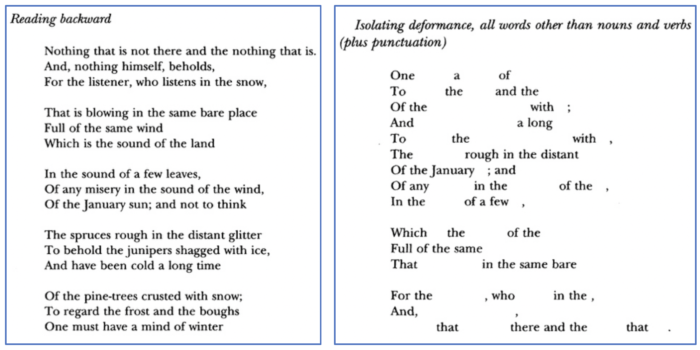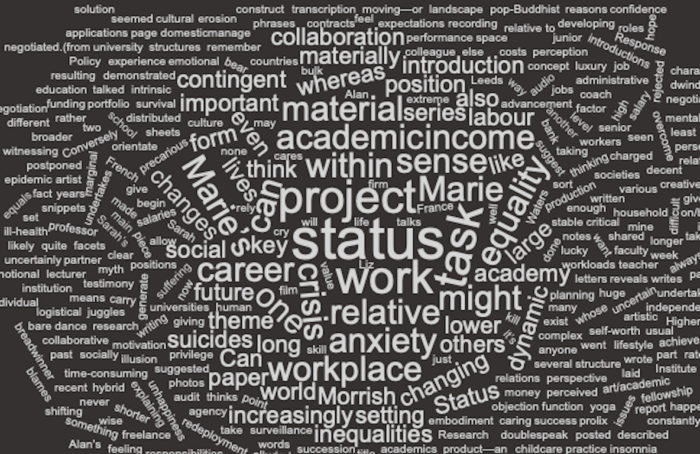Task 39 - Deforming the Self
Alan writes:
Your surprising response to Task 37—in which you took the text from the task I set and foregrounded the ‘small’ words that were its obscured underpinning—recalls an approach to scholarship known as ‘deformative criticism’, as described in Buurma and Gold (2018: 146-7; they put the emphasis on the digital, but that aspect is not essential):
a playful method that aims to deliberately transform the texts it engages. Deformative readers explore textual corpora not to unearth facts and patterns but rather to deliberately mangle those very facts and patterns, to interfere consciously with the computational artefact and to replace the imperatives of distant reading—hypothesis and experiment—with a new set of priorities that include alteration, randomness, and play. […] [Deformative criticism is] a form of computational reading (or mis‐reading) that reject positivistic methods and embrace the humanistic values of ambiguity and play.
Here are some examples, from Samuels and McGann, in which they deform ‘The Snow Man’, a poem by Wallace Stevens. In the first, they ‘read’ (lay out) the poem ‘backwards’ by reversing the order of verses from last to first; in the second, they omit all verbs and nouns:
For Samuels and McGann, using this creative-deformative procedure, ‘the critical and interpretive question [becomes] not “what does the poem mean?” but “how do we release or expose the poem’s possibilities of meaning?”’ (p. 28). The procedure, they say, is intended to show how the poem’s ‘pretensions to meaning are not so much a function of ideas as of style’ (p. 37).
Your own deformative version of the text of Task 37 seems to me to have an interesting edge. It resists the tyranny of the algorithmic in the word cloud I used to abstract and illustrate the text of the task (see above). The online mechanism to which I subjected my text (I don’t now remember the website I used) was plainly programmed to omit the small words (prepositions, conjunctions, articles) when calculating word frequency. And yet, as you show in your deformative version of the same text, these small words, and the preposition ‘of’ in particular, are constitutive of the text and essential to its effectiveness as communication: their very transparency or invisibility aids the rhetoric. They are the pawns or the foot soldiers or, in the callous disdain of the word-cloud algorithm, the cannon fodder of discourse. There’s something, I’m tempted to say, political in the act of restoring them to the prominence of a large font size and weight.
Your task
This week you have an important meeting in which you discuss your ideas for doctoral study with Andreas Roepstorff, a senior academic from Aarhus University. We have talked about how you hope to present the range and particularity of your interests in order to reveal the originality of their intersections. But my question is—what gets obscured in this process? What are the discursive pawns and cannon fodder in your own self-representation?
So, your task is to produce a deformative version of the presentation you make to Andreas, one that restores to prominence the banal and taken-for-granted underpinnings of your attempt to persuade of your academic potential.
References
Buurma, Rachel Sagner and Matthew K. Gold (2018). ‘Contemporary proposals about Reading in the Digital Age’, in David H. Richter (ed.), A Companion to Literary Theory (Oxford: Wiley Blackwell), 139-150
Samuels, Lisa and Jerome McGann (1999). ‘Deformance and Interpretation’, New Literary history 30:1, 25-56


